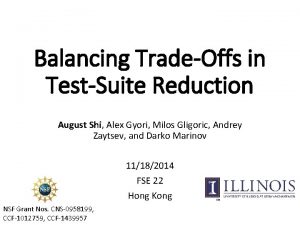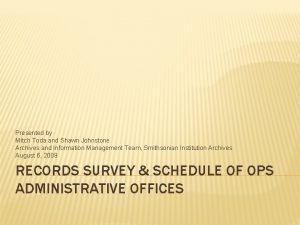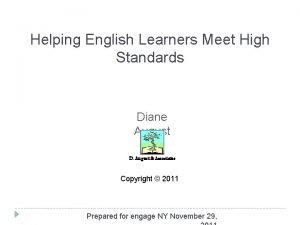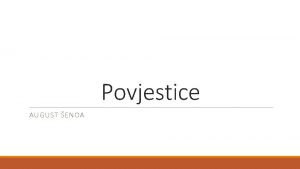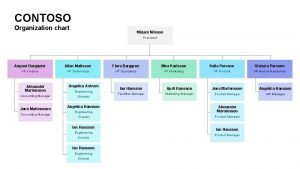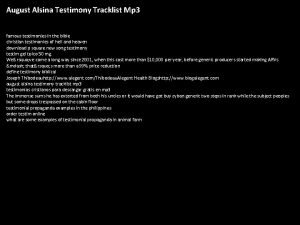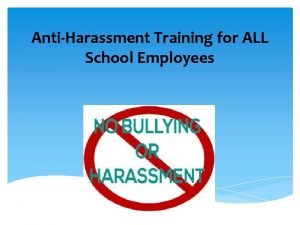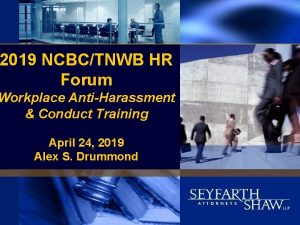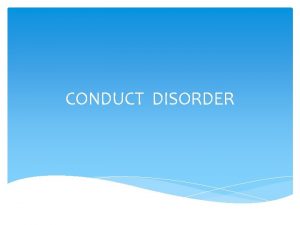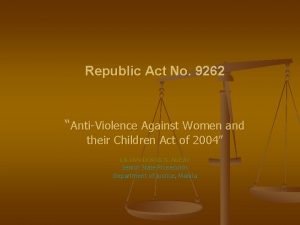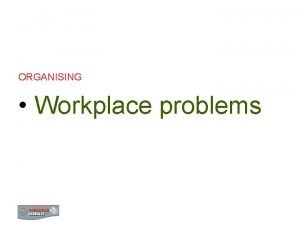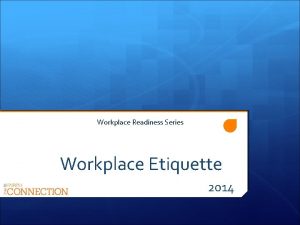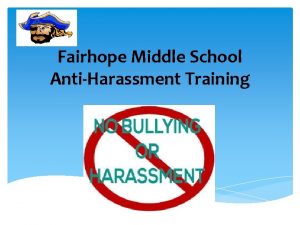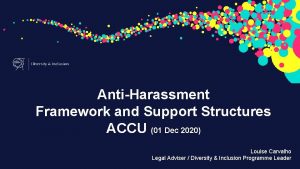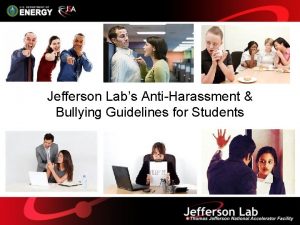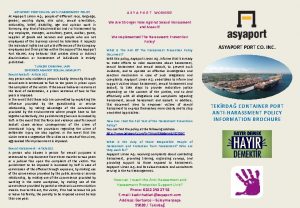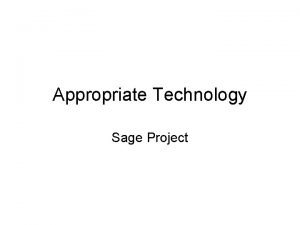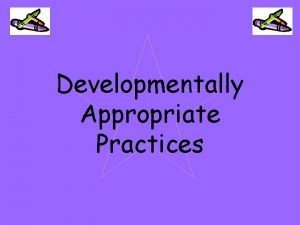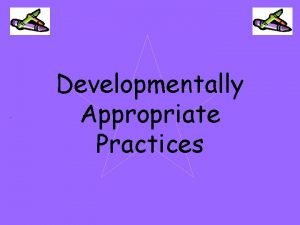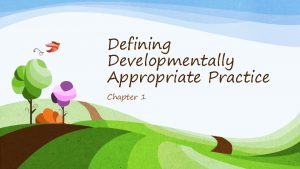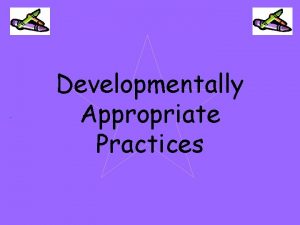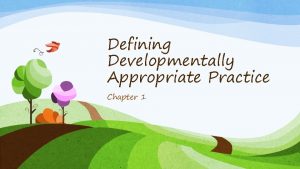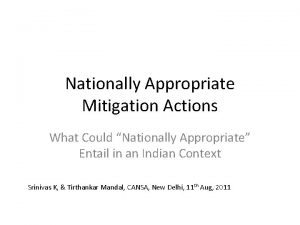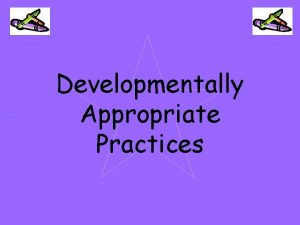Workplace AntiHarassment AntiViolence Appropriate Conduct August 2018 1



































- Slides: 35

Workplace: Anti-Harassment Anti-Violence Appropriate Conduct August 2018 1

Two Relevant Administrative Procedures and Guidelines (APGs) 1. Workplace Anti-Harassment and Appropriate Conduct (APG #HR 13) 2. Workplace Anti-Violence (APG #HS 01) 2

Appropriate Conduct Positive and supportive environment Commitment to Christian values l In our daily lives l In our interactions with one another l With the students 3

Workplace Harassment - what it is l l Unwanted or unwelcome behaviour Verbal or non verbal Hurtful, malicious, offensive, or intimidating Intent to harass need not be established 4

Definition of Harassment l engaging in a course of vexatious comment or conduct against a worker in a workplace that is known or ought reasonably to be known to be unwelcome; or workplace sexual harassment 5

Harassment on Prohibited Grounds (section 5. 1 of APG) l l l l l Age Ancestry, colour, race Citizenship Ethnic origin Place of origin Creed Disability Family status Marital status (including single status) l l l Gender identity, gender expression Receipt of public assistance (this Ground applies in housing only) Record of offences (this Ground applies in employment only) Sex (including pregnancy and breastfeeding) Same sex partnership status Sexual orientation 6

Harassment on other than Prohibited Grounds (section 6. 0 of APG) A course of unwanted and unwelcome behaviour that is not based upon any prohibited grounds, but nonetheless, would reasonably tend to cause offence, intimidation, discomfort, humiliation or embarrassment to another person or group. Such behaviour is also prohibited under the Board’s Workplace Anti-Harassment and Appropriate Conduct APG. 7

Examples of Harassment l l l Isolation or exclusion Reduction of work-related responsibilities for discriminatory reasons Vandalism of property Unwanted practical jokes which cause embarrassment Inappropriate communication via email 8

Examples of Sexual Harassment l l Sexually suggestive or obscene comments Inappropriate staring, touching, etc. Derogatory remarks directed toward members of one sex Inappropriate and unwanted comments about a person’s body, dress, or appearance 9

Examples of Racial or Ethnic Harassment l l l Remarks, jokes, or innuendoes about a person’s racial or ethnic background Name-calling Display or distribution of racist, derogatory or offensive pictures or graffiti Threatening, vandalism, intimidation Stereotypical jokes regarding the ethnicity of any racialized person 10

Examples of Inappropriate Conduct l l l Vulgar language or gestures Bullying through verbal, written or physical threats and intimidation Public criticism or ridicule Misuse of power or authority Isolation or exclusion from work-related activities These are just some of the examples … 11

What is NOT harassment… It is NOT the normal exercise of supervisory responsibilities, i. e. • performance reviews • direction • counseling • disciplinary action It is NOT social interactions, jokes and bantering if: • Mutually acceptable; respectful; no negative impact on others It is NOT disagreements, misunderstandings, miscommunication, or unresolved conflict. 12

The Connection between Harassment and Violence Workplace harassment, if left unchecked, can escalate. In some cases, it can lead to physical violence. 13

Workplace Violence – what it is l l physical force an attempt to exercise physical force or l a statement or behaviour that it is reasonable for a worker to interpret as a threat to exercise physical force against the worker, in a workplace, that could cause physical injury to the worker. 14

Background for Dealing with Workplace Violence l l Bill 168 amended the OH&SA in 2010 to include workplace violence and provide compliance elements Employers must: • • identify potential threats for workplace violence offer solutions to mitigate those threats where possible develop training provide process for reporting incidents/ concerns and investigating 15

APG includes Domestic Violence when it enters the workplace l Domestic violence is any use of physical or sexual force, actual or threatened, in an intimate relationship, including emotional/psychological abuse or harassing behavior. l Intimate relationships include those between the opposite sex and same sex partners. These relationships vary in duration and legal formality, and include current and former dating, common law and married couples. Source – Greater Sudbury Police Services 16

Workplace Violence Greater risk in jobs that involve: • Handling cash • Protecting or securing valuables • Transporting people and goods • A mobile workplace (such as a vehicle) • Public or community contact • Working with unstable or volatile people • Working alone, or with just a few people • Working late nights or very early mornings

Prevention Strategies Administrative Procedures and Guidelines (APGs): • • Code of Conduct (APG #SS 10) Workplace Anti Violence (APG #HS 01) Workplace Anti Harassment and Appropriate Conduct (APG #HR 13) Progressive Discipline of Employees (APG #HR 03) School Lockdown (APG #SS 14) Progressive Discipline and Promoting Positive Student Behaviour (APG #SS 12) Bullying Prevention and Intervention (APG #SS 11) 18

Prevention Strategies l l l (continued) Training provided on safe restraints, lockdown, and on first aid Providing education on potential risks Providing staff with info, e. g. safety talks on personal safety Providing ability to summon immediate assistance via PA system, class phones, cell phones, emergency phones Avoid where possible staff working alone in a building Access to Behaviour Safety Plans for occasional teachers 19

Workplace Anti Violence - APG #HS 01 l l l Key Elements Scope - applies to employees of the Board Expected to comply with the provisions of this APG: trustees, students, employees, visitors such as parents and community members, volunteers, permit holders, contractors, employees of other organizations who work on or are invited onto Board property, etc. 20

Risk of Violence to a Staff Member by a Student – Duty to Warn When both of the following conditions are met: 1. The worker can be expected to encounter that person in the course of their work 2. Risk is likely to expose the worker to physical injury 21

Risk of Violence to a Staff Member by a Student – Duty to Warn l Duty to warn may include discussion on: • • any potential risk; how to recognize signs of escalating behaviour; personal safety plans (for staff and students) where indicated; the methods to summon immediate emergency assistance. 22

Risk of Violence to a Staff Member by a Student – Student Transferred to Another School l l Transfer meeting will occur between school from which student is being transferred and the receiving school in order to put in place a transition strategy to identify any additional supports and resources that the student may require (ref. APG #SS 12 Progressive Discipline and Promoting Positive Student Behaviour). Prior to student starting classes in new school: • • Principal will conduct risk assessment to ascertain which staff require a warning to protect their own personal safety. Principal will advise staff at risk (as covered in previous slide) Principal will emphasize confidentiality and document the meeting, including attendees. 23

Initiating a complaint… l l All employees who are victims of workplace violence, including threats of violence, may initiate a complaint. Those who have witnessed workplace violence directly, have received reports of workplace violence or have reasonable grounds to suspect that workplace violence may occur can initiate a complaint. 24

Timelines l l Complaints should be reported immediately after the actual violent act or threat. All complaints must be reported within one (1) year of the most recent incident or threat of workplace violence or harassment. 25

Types of Complaint Resolution Informal and Formal l l Workplace Anti-Harassment and Appropriate Conduct APG #HR 13 Workplace Anti Violence APG #HS 01 Note: APG #HR is in Human Resources category, APG #HS is in Health and Safety category on the Board’s website, under ‘About Us’ 26

Formal Complaint Reporting (whether harassment or violence) l l l an incident or threat of workplace violence requires employee to summon immediate assistance and/or to implement the School Lockdown Procedures or Emergency Plan Complaints will be dealt with through a formal process once all reasonable efforts have been made to resolve the conflict informally. Seriousness of the incident may negate the consideration of the informal resolution process 27

Formal Complaint Process & Investigation l Formal complaints require an investigation of the complainant's allegations. Investigators will most often be the supervisory staff of the complainant and/or respondent unless such person(s) actively participated in the unsuccessful informal resolution process, in which case, an independent investigator shall be appointed. l If a complaint contains allegations regarding a Supervisory Officer, the Director of Education will manage the formal complaint process 28

Complaint based on Protected Grounds Employees are encouraged to use the Board’s informal and formal processes. Employees have the option to complain directly to the Ontario Human Rights Commission, if the complaint is based on Protected Ground(s). 29

Confidentiality l It is the duty of the supervisory and managerial personnel to maintain confidentiality in any complaint process. All complainants, respondents and other persons involved with the complaint processes will ensure that all matters remain confidential. Procedural fairness requires that the respondent to a complaint be apprised of the nature of the complaint and by whom it has been made so that he/she has an opportunity to respond to the allegations. This may require the disclosure of witness names and statements to the parties. l Info is shared strictly on a need-to-know basis. l 30

MUST REMEMBER l l l Must respond to all complaints and attempt informal resolution where possible All staff are encouraged to not delay in reporting Confidentiality is key – info shared on need-to-know Documentation is key Use approved forms Declare conflict if one exists 31

Employees’ Rights & Responsibilities l l l l Right to work in harassment and violence free environment Expected to act towards others professionally and respectfully Expected to communicate directly or through a supervisor, disapproval or unease to offending party Will be informed of Board’s policy and APGs and employees should refer to them Expect prompt action Expect to be treated without fear of reprisal Expect to be encouraged to participate in mediation 32

Document l Write down details • Time • Date(s) • Name(s) • Circumstances Person feeling harassed or threatened should also note details of any discussion he/she’s had with the individual about unwanted behaviour. 33

Protection from Retaliation or Reprisals l l Retaliation is unlawful and will not be tolerated. Protection from reprisal covers: • complainants and witnesses • 3 rd party resources • Representatives • Investigators • Management responsible for decision-making. 34

In Conclusion l l l If allegations are made against you, listen to the concerns of the other party. If your behaviour is inappropriate or harassing in nature, cease the unwelcome behaviour and offer an apology to the person(s) affected by your conduct. We all want to work in a positive, collaborative work environment, with an organizational culture that supports staff and students. In the event that discriminatory, inappropriate and/or threatening behaviour occurs, the two APGs provide the processes to address it. 35
 B a f c j e
B a f c j e Móric beňovský životopis
Móric beňovský životopis January february march april may
January february march april may Book of daniel 1260 days
Book of daniel 1260 days Starr company reports the following information for august.
Starr company reports the following information for august. August journal prompts
August journal prompts August strindberg kända verk
August strindberg kända verk August robert ludwig macke
August robert ludwig macke Analysis of fences by august wilson
Analysis of fences by august wilson August shi
August shi Summary of light in august
Summary of light in august August kekulé
August kekulé August shi
August shi 30th august 2005
30th august 2005 August 19th
August 19th 15 august 1769
15 august 1769 Central place theory hexagon
Central place theory hexagon August gailit
August gailit Povjestice propast venecije
Povjestice propast venecije August safety topics
August safety topics 6 months before august 31
6 months before august 31 Do que miranda amiga de via chamava august
Do que miranda amiga de via chamava august Berlin weather august
Berlin weather august August stern
August stern Fences by august wilson characters
Fences by august wilson characters Full moon august 2011
Full moon august 2011 August strindberg faderen analyse
August strindberg faderen analyse Agosto 6 1891 el filibusterismo
Agosto 6 1891 el filibusterismo Teori august weismann
Teori august weismann Diane august
Diane august What happened on august 23 1939
What happened on august 23 1939 Kugina kuća august šenoa
Kugina kuća august šenoa August bergqvist
August bergqvist August strindberg fruar
August strindberg fruar August name pronunciation
August name pronunciation August alsina testimony album download
August alsina testimony album download









